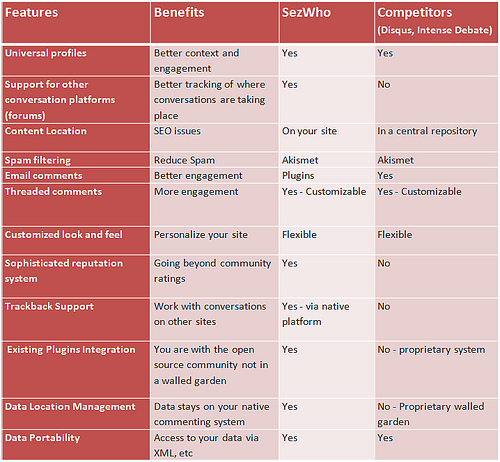After my post on the 4 commenting services Commenting Services Face to Face: Disqus vs IntenseDebate vs JS-Kit vs SezWho, I have started to receive back a lot of feedback. I’d like to thank all the people that took their time to go through the article and send me their feedback.
Based on this feedback, I feel that an update is needed as the information might change the final evaluation. As a quick reminder my final ranking was something like:
Blog
- Winner: IntenseDebate
- Runner-up: Disqus
Site
- Winner: Disqus
- Runner-up: IntenseDebate
Now, if you check the different matrices in my initial post, you’ll notice that there is a question that isn’t really answered: why JS-Kit doesn’t show up in my final top? I have to confess that compared with the rest of the article which tried to be as objective as possible, the answer to this question was a bit more subjective and it was heavily influenced by the fact that JS-Kit is was offering the FREE widget for only 25k pageviews. But, for some the JS-Kit’s freemium model may be more comfortable as it may be seen as a guarantee that the initial investment will not go away any time soon.
I should also mention that there have been a major upgrade to the freemium model and now the free version is available for up to 5 mil pageviews (see more details about JS-Kit pricing).
IntenseDebate updates
Spam filtering
IntenseDebate offers integration with Akismet for spam filtering. The option is available on the account dashboard.

Data Access
There are 2 updates related to the data access in IntenseDebate:
- IntenseDebate offers through the account dashboard an export to XML function

- IntenseDebate is currently working on an API. It wasn’t yet launched and I haven’t had the chance to check it yet. I am in contact with their support team and hope to have a more detailed update on this topic.
IntenseDebate Matrix
| Comment Threading: |
Y |
| Anonymous Comments: |
Y |
| Bookmarkability |
Y |
| Comment ranking |
Y |
| Comment ranking functionality |
Y |
| Rich format comments |
Y |
| Spam filtering: |
Custom + Akismet |
| Comment Moderation: |
Y
(web + email) |
| Search Engine Friendliness |
Y (for platforms support by the plugin)/N for custom web sites |
| HTML/CSS Customization |
Y |
| Widget (JS API): |
Y |
| Programming API: |
private (work in progress) |
| Data export |
Export as XML |
| Costs |
Free |
Documentation
Support |
GetSatisfaction |
With these updates, it looks like the only missing piece from the IntenseDebate offering is the lack of an off-the-shelf SEO friendliness feature. Moreover, this missing feature applies only for custom web sites that are not able to use the IntenseDebate integration plugins.
JS-Kit updates
Model/Costs
While, at the time of my initial comparison, the JS-Kit FREE version was available for 25k pageviews, JS-Kit has pushed a major update and now JS-Kit FREE applies for 5mil pageviews. This is imo a major change in their offering, one that makes me feel that JS-Kit wins its place in my top.
Data access
In my initial matrices, JS-Kit is missing both a Programming API and Data Export functionality. Well, I have some good news about these: JS-Kit folks are working on a public API and I hope to get access to it very soon and add more details. Also, JS-Kit offers access to all the comments through RSS. While, this is not optimal, your comments are not completely locked-in and so JS-Kit cannot score 0 anymore.
Search Engine Friendliness
In the previous post, I’ve been complaining about the fact that I wasn’t able to search the JS-Kit forum for more details. It looks like I was a bit wrong and the forum search functionality is in fact available, but a bit hidden under the Control link:
The guys from JS-Kit have promised to improve the widget UI so that the search functionality to become more visible and easily to access.
Also, having in mind the SEO solution created by JS-Kit (and then re-used by other commenting services), search engines should be able to correctly index the comment threads.
JS-Kit Matrix
| Comment Threading: |
Y |
| Anonymous Comments: |
Y |
| Bookmarkability |
N |
| Comment ranking |
Y |
| Comment ranking functionality |
Y |
| Rich format comments |
Y |
| Spam filtering: |
Custom + Akismet |
| Comment Moderation: |
Y
(web + email) |
| Search Engine Friendliness |
Y (for platforms support by the plugin)/N for custom web sites |
| HTML/CSS Customization |
Y |
| Widget (JS API): |
Y |
| Programming API: |
private (work in progress) |
| Data export |
RSS |
| Costs |
Freemium model (see JS-Kit pricing for more details) |
Documentation
Support |
Q&A Forum, on site documentation, PDF |
Conclusion
Based on the new information, I’d say that the top has changed a bit and without further ado, here is the new ranking:
Blog
- Winner: JS-Kit
- Runner-up: IntenseDebate
Site
- Winner: Disqus
- Runner-up: IntenseDebate and JS-Kit
More JS-Kit Features
I have received a ton of information on JS-Kit features, so I’m sharing here with you. If guys from Disqus and IntenseDebate are willing to share their complete feature list, I’d be glad to publish it.
User Related Features: JS-Kit Additions
- Ability to get replies to comments via email. Ability to respond with email. Response automatically inserted into the comment thread.
- Private messaging between commentors.
- Ability to embed and play YouTube videos within comments. (configurable through the JS-Kit admin interface)
- Ability to upload photos up to 10MB in size with automatic thumbnail generation. (configurable through the JS-Kit admin interface)
- Facebook Connect and OpenID support
Owner Related Features: JS-Kit Additions
- Obscenity filters
- Support for multiple administrators and sub-section moderation (eg. you can only moderate this \subdomain)
- Community moderation. “Mark as offensive” is set by blogger to N, where N = remove comment and place in pre-moderation
- Selective moderation (eg. Once the blogger approves a commentor N times, that commentor is no longer moderated)
- JS-Kit also provides Ratings and Polls for bloggers using the same cusomization, support, and administration system
- (integration with blogging platforms) Option to highlight Blogger comments with a different background color.
Data Access: JS-Kit Additions
- (integration with blogging platforms) JS-Kit innovated “Sync” which automatically updates the base platform with all new comments.














